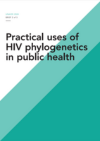Publications - Released in 2024
Phylogenetic approaches have been used to study HIV biology and epidemiology since the early 1980s. In the last 15 years, advances in sequencing have led to an increase in the information obtained and a sharp drop in costs, making it feasible to use phylogenetics in larger studies and public health HIV surveillance programmes. This is the second brief in a series of three on HIV phylogenetics.
The first brief, The Application of Phylogenetics to HIV—Insights into Biology and Epidemiology of HIV, explains the methods and approaches used to generate genetic and phylogenetic data and analyses. This brief summarises the ways in which phylogenetic (and other sequence-based) analyses are currently being used and reflects on how they could be used in the future in the field of HIV research and public health. The third brief discusses the ethical challenges of using HIV phylogenetics in research and public health surveillance.
Organizations
- Joint United Nations Programme on HIV/AIDS (UNAIDS)






